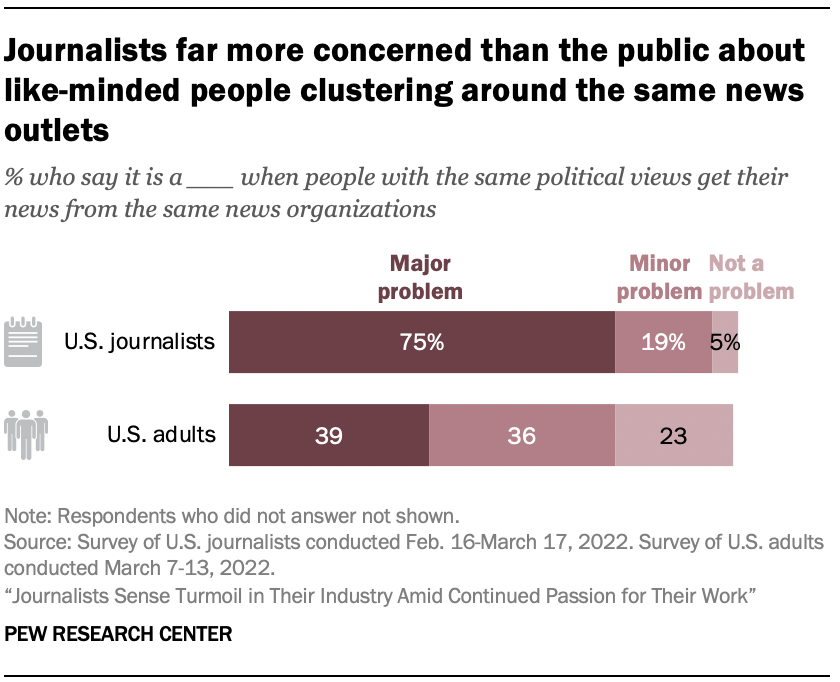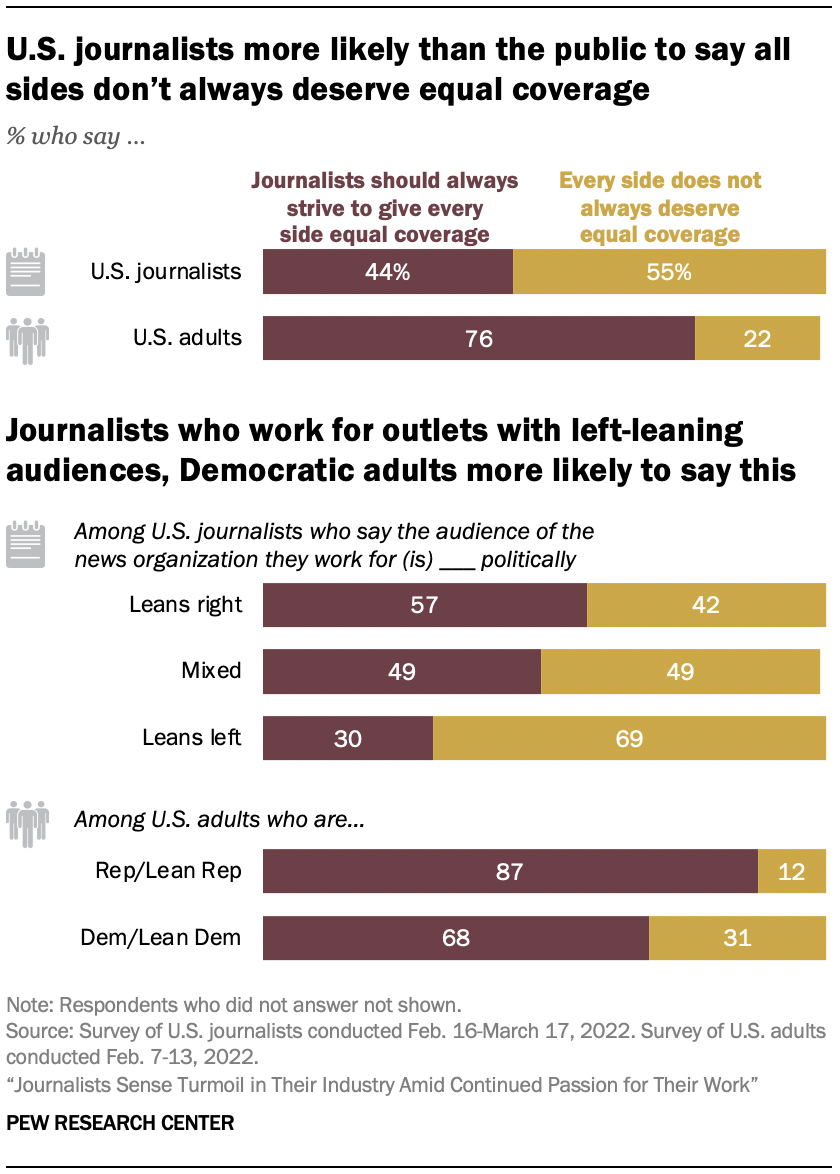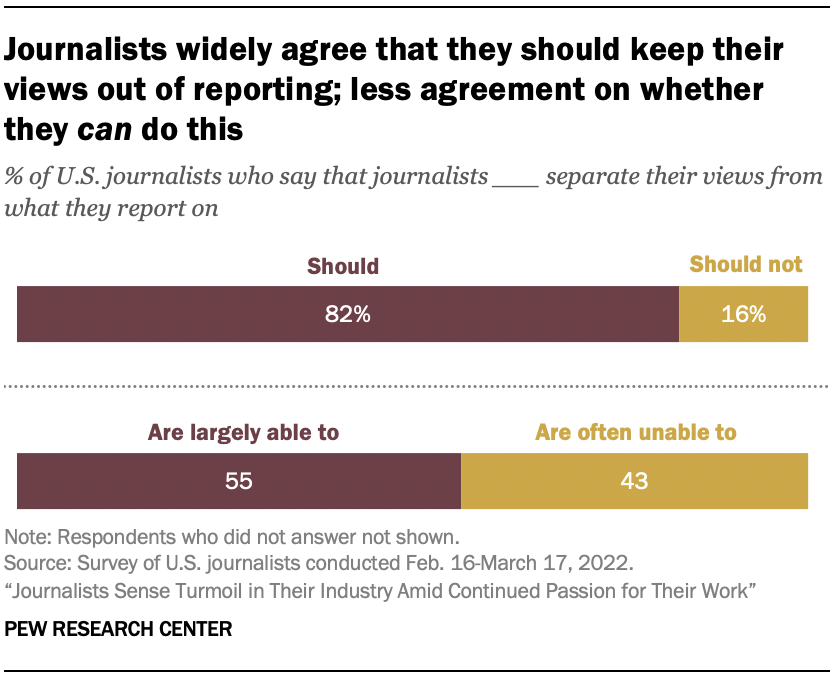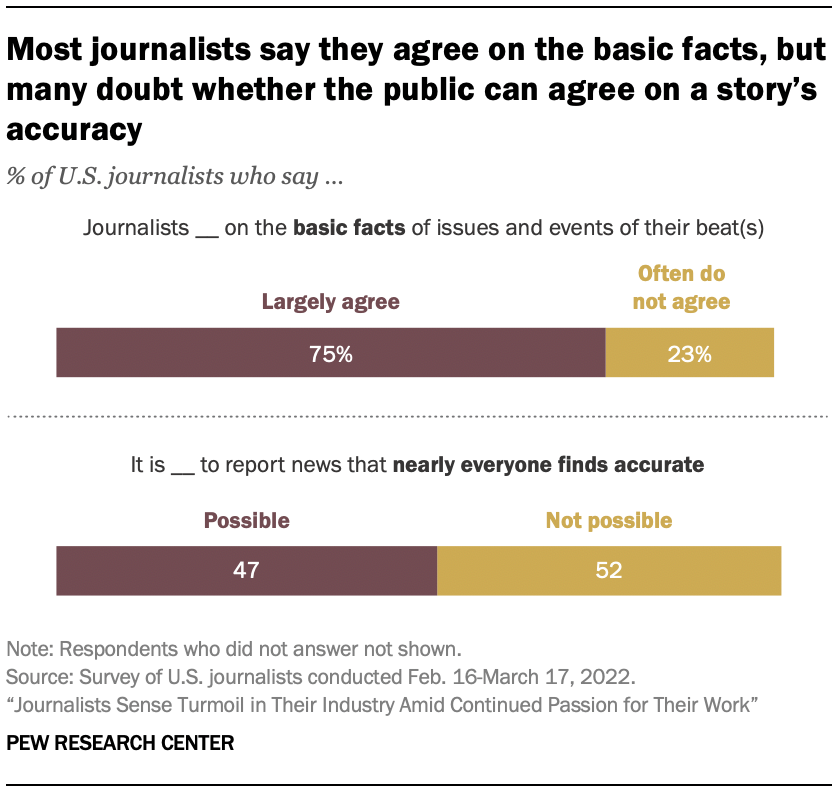Americans’ increased political polarization has also played out in the news environment in various ways, including the sources people turn to for news, what they believe about certain current events, and their views of the news media more broadly. As a part of this study, researchers explored the thoughts of journalists themselves about the impact of the country’s political dynamics on journalism and the information environment more broadly.

Overall, journalists are far more concerned than the American public about people with similar political views getting news from the same sources. Three-quarters of journalists surveyed say this is a major problem, and another 19% say it is a minor problem. Just 5% do not see it as problematic.
This concern cuts across both journalists who say their news organization’s audience leans to the right politically and those who say their audience leans left. (Those working for more than one organization were asked about the main one they work for.) Among those who say their organization’s audience leans to the right politically, nearly three-quarters (73%) say the political sorting of news audiences is a major problem, as do 71% of those whose audience leans to the left and 79% of those who say their audience is more politically mixed. (See Appendix for the portion of the sample who say their organization’s audience leans one way or the other politically.)
The American public is not as concerned. In a separate representative survey of 10,441 U.S. adults conducted March 7-13, roughly four-in-ten U.S. adults (39%) say it is a major problem when people with similar political views get news from the same organizations. About the same percentage (36%) say it is a minor problem, while 23% say it is not a problem at all – nearly five times the share of journalists.
Journalists less likely than the public to say each side of a story always deserves equal coverage

Another area of journalism that is often seen through a political lens is the question of news stories representing “all sides” of an issue and/or giving equal voice. This concept is often referred to as “bothsidesism” in journalism – which revolves around whether those making false statements or unsupported conjecture warrant as much attention as people making factual statements with solid supporting evidence.
This debate gained a new level of intensity during Donald Trump’s presidency and the widespread disinformation and competing views around both the 2020 election and the COVID-19 pandemic.
A small majority of journalists (55%) say that every side does not always deserve equal coverage, while 44% say journalists should always strive to give every side equal coverage.
The American public, on the other hand, expresses much stronger support for the concept of equal coverage. In another representative survey of 9,388 U.S. adults conducted Feb. 7-13, about three-quarters of U.S. adults (76%) express the view that journalists should always strive to give every side equal coverage. Majorities in both parties feel this way, although Republicans and those who lean toward the GOP (87%) are more inclined than Democrats and Democratic leaners (68%) to hold this view.
This is also an area where journalists themselves disagree based on the political leaning of their news organization’s audience. Journalists who say their news organizations have audiences that lean to the right politically are much more likely to endorse equal coverage of all voices than those who say their organizations’ audiences lean left. Nearly six-in-ten journalists with right-leaning audiences (57%) say journalists should always strive to give equal coverage, almost twice the share who say this among those with left-leaning audiences (30%), and somewhat higher than the share among journalists who say their outlet has a politically mixed audience (49%).
Journalists have mixed views on whether they can keep their personal views out of their reporting
One of the central questions about bias in news coverage is whether journalists can detach their personal views from their work. While journalists strongly agree that they should keep their personal views out of their reporting, there is less agreement over whether they are able to do so.

A large majority of journalists surveyed (82%) say journalists should separate their views from what they report on. A considerably smaller majority (55%) think journalists are largely able to do this, while 43% say journalists are often unable to do so.
These figures are similar regardless of journalists’ audience makeup: 55% of those who say their organization’s audience leans to the right politically feel journalists are largely able to separate their views from their reporting, as do 52% of those who say their audience leans left and 58% who say their organization’s audience is politically mixed.

Still, three-quarters of U.S. journalists believe in journalists’ ability to agree on the basic facts of issues and events in the topic area (or beat) they cover, even if journalists report on these facts in different ways.
Many journalists acknowledge that significant segments of the public will not find their stories accurate. About half of journalists in the survey (52%) say it is not possible to report news that nearly everyone finds accurate, while 47% say it is possible to do so.
The public is even more pessimistic than journalists on this front, with 62% saying it is not possible to report news that nearly everyone finds accurate, far more than the 37% who say this is possible.


 What do journalists think the news industry does best and worst?
What do journalists think the news industry does best and worst?